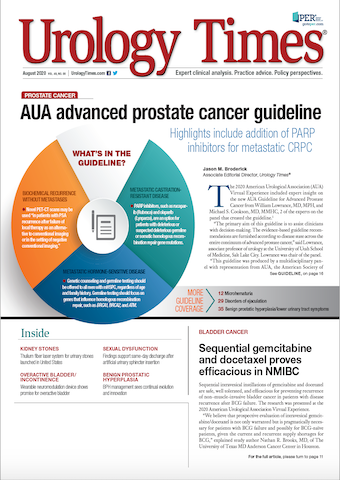Publication
Article
Urology Times Journal
Microhematuria guideline emphasizes risk-stratified approach
Author(s):
A multidisciplinary panel outlines criteria for stratifying risk for genitourinary malignancy in patients with microhematuria.
A new clinical guideline for microhematuria embraces a risk-stratified approach to evaluating patients.
The guideline was presented at the 2020 American Urological Association Virtual Experience by guideline panel co-chairs Daniel A. Barocas, MD, MPH, associate professor and vice chair of urology at Vanderbilt University Medical Center, Nashville, Tennessee, and Stephen A. Boorjian, MD, professor of urology at Mayo Clinic, Rochester, Minnesota.1
The multidisciplinary panel included members of the AUA, Society of Urodynamics, Female Pelvic Medicine & Urogenital Reconstruction, American College of Obstetricians and Gynecologists, as well as a patient advocate from the Bladder Cancer Advocacy Network. The panel’s evidence base consisted of 5 systematic reviews and 91 primary literature studies.
In presenting the guideline, Barocas explained that hematuria is one of the most common urologic diagnoses, “by some estimates accounting for 25% or more of urologic evaluations.”
Barocas also discussed the variability related to microhematuria evaluation.
“There is quite a bit of variability across current guidelines and consensus statements regarding the definition of microhematuria, criteria for evaluation, and the components for evaluation, including the optimal imaging modality,” Barocas said.
With the guideline, Barocas said the panel sought to address the following issues: conflicting guidelines, a low overall yield of evaluation, harms of evaluation in terms of risks to patients and cost to the health care system, and poor adherence to existing guidelines.
Defining microhematuria
The guideline panel defines microhematuria as “[greater than or equal to] 3 red blood cells per high-power field on microscopic evaluation of a single, properly collected urine specimen.”
The guideline further advises that clinicians not define microhematuria solely by positive dipstick testing alone but rather proceed to formal microscopic evaluation of the urine following a positive dipstick test.
Daniel A. Barocas, MD, MPH

“This is because a variety of factors, including myoglobinuria, dehydration, exercise, and beta dyeing, can produce false-positive dipstick results,” Barocas said.
Barocas also described statements of the guideline related to patients diagnosed with gynecologic or non-malignant genitourinary sources of microhematuria. For these patients, the clinician should conduct a repeat urinalysis following the resolution of the gynecologic or non-malignant genitourinary cause.
Following this, “If the hematuria persists or the etiology can't be identified, clinicians should perform a risk-based evaluation. By the same token, in patients with hematuria attributed to a urinary tract infection, clinicians should obtain a urinalysis with microscopic evaluation following treatment to ensure the resolution of the hematuria,” Barocas said.
During his presentation, Boorjian described the risk stratification components of the guideline.
“The development of a risk classification system represents a recognition on the part of the
Stephen A. Boorjian, MD

guidelines panel of the heterogeneity in risk among patients presenting with microscopic hematuria for underlying genital urinary malignancy and an effort to provide an individualized approach to evaluation,” Boorjian explained.
The guideline directs clinicians to categorize patients presenting with microhematuria as being at low, intermediate, or high risk for genitourinary malignancy. Criteria for risk stratification are outlined in the guideline and include age, smoking status, degree of microhematuria, persistence of microhematuria, history of gross hematuria, and additional urothelial cancer risk factors.
In patients categorized as low risk, the guideline recommends a shared decision-making process to choose between repeating urinalysis within 6 months or proceeding with cystoscopy and renal ultrasound. Low-risk patients who choose not to undergo initial cystoscopy or upper tract imaging but are found to have microhematuria after repeat urine testing should be reclassified as intermediate or high risk and should then undergo cystoscopy and upper tract imaging.
Cystoscopy and renal ultrasound are recommended in patients with intermediate-risk microhematuria.
“The panel wants to emphasize that the overwhelming majority of genitourinary malignancies diagnosed among patients with microscopic hematuria are bladder cancers, and therefore cystoscopy represents an absolute cornerstone to the evaluation of microhematuria patients,” Boorjian said.
In patients categorized as being at high risk for malignancy, the guideline recommends that clinicians perform cystoscopy and axial upper tract imaging.
The guideline also covers urinary markers: “Recognizing the insufficient data existing to date on the incremental additive value to detect bladder cancers, the recommendation of the guidelines is that clinicians should not use urine cytology for urine-based tumor markers in the initial evaluation of patients with microhematuria, acknowledging that clinicians may obtain urine cytology for patients with persistent microhematuria after a negative workup who have irritative voiding symptoms or risk factors for carcinoma in situ,” Boorjian said.
Recommendations for follow-up
Regarding follow-up after a negative microhematuria evaluation, the panel says clinicians may obtain a repeat urinalysis within 12 months, and that in patients with a prior negative evaluation and subsequent negative urinalysis, clinicians may discontinue further evaluation for microhematuria. For patients with a prior negative microhematuria evaluation who have persistent or recurrent microhematuria at repeat urinalysis, the panel advises shared decision-making regarding the need for further evaluation.
“Importantly, patients who experience a change in their clinical status should have further evaluation. Specifically, patients who develop gross hematuria, patients who develop new urologic symptoms, or an increase in their degree of microhematuria should initiate further evaluation,” Boorjian said.
Reference
1. Barocas D, Boorjian S, Alvarez R, et al. Microhematuria: AUA/SUFU guideline. Presented during 2020 AUA Virtual Experience. June 27-28, 2020
































